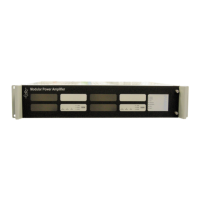iPAM400 – Product Manual
U-0629-0171.doc – Issue: 04 complete, approved
Page 17 of 138
2.3 Amplifier Modules
The MX amplifier modules use ASL proprietary Adaptive Class D technology to achieve high efficiency and
low quiescent current. They are designed to produce 100 V RMS across their rated load being stable into
loads from short to open circuit. The MX series
1
of amplifier modules comprises the following modules:
• MX100 100 W Amplifier Module
• MX200 200 W Amplifier Module
• MX400 400 W Amplifier Module
The MX100, MX200, and MX400 amplifier modules respectively occupy one, two or four slots in the iPAM400
mainframe. A front fascia panel is fitted to the mainframe to provide protection for the amplifier module(s)
and annotations for the LED indicators.
The amplifiers are designed such that audio performance will not be significantly affected when the battery
voltage drops to 21 V, ensuring that the full audio output (+0, –1dB) is attained at this battery voltage.
ASL amplifiers on 230 V mains power can produce full output, with normal programme material, into loads
25% greater than those specified. In these conditions, a MX100 will deliver full output with 125 W of load
connected, a MX200 will deliver full output with 250 W of load connected, and a MX400 will deliver full
output with 500 W of load connected.
2.4 Amplifier Health Monitoring
Amplifier health monitoring is accomplished by detection of infrasonic tones at the amplifier output and
input terminals. The detection of surveillance tone and the fault threshold levels must be configured during
the system commissioning.
Amplifier input fault is reported when the measured input surveillance level falls below the commissioned
threshold which is 70% of the measured value. The fault is reported within 100 seconds of the fault being
induced.
Discrimination between amplifier failure and output signal failure is accomplished by logical process; see
Section “2.4.3.1.3 Total Line Short Circuit Fault or Amplifier Failure” (page 20).
2.4.1 Surveillance Tone Frequency and Level Compatibility
Amplifier health monitoring is compatible with sinusoidal surveillance tones in the 20 Hz-40 Hz frequency
range with 1-2 V RMS amplifier output.
2.4.2 Pulsed Surveillance Tones
The amplifier health monitoring system accepts pulsed surveillance tones within the following parameters:
• Repetition: continuous to 50 seconds
• Duration: 1 second to continuous
1
These amplifier modules are electrically identical to the M series amplifier modules, but with different mechanics and connectors
to match the iPAM400 mainframe.

